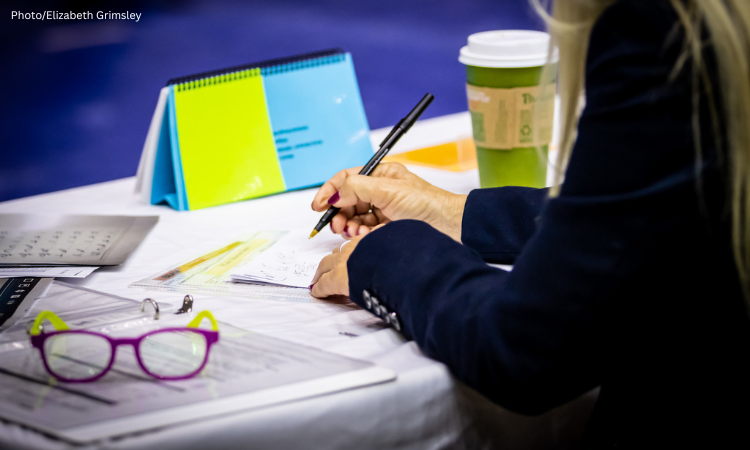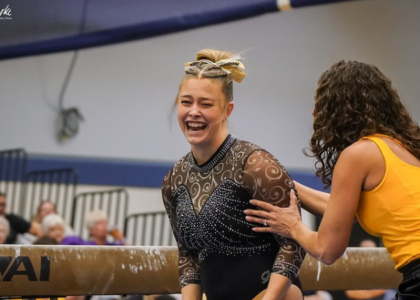In this article, I take a deep dive into the world of Division III gymnastics. Division III programs do not provide athletic scholarships, making recruiting the highest performing athletes more difficult. These programs take pride in developing gymnasts that may not have been the highest performing athletes in high school but have grown into strong athletes and performers in their own right in college.
The fact that top teams enjoy significant recruiting advantages, as well as large program budgets, makes it hard for lower-resource schools to keep up. Brockport has the highest NQS ranking of any Division III program at 66 of 84 teams.
For this article, I wanted to know if there was also bias from the judges in evaluating Division III routines. Perhaps because they are not scholarship athletes, judges expect a lower quality of gymnastics or feel more confident taking smaller deductions that may not be taken in Division I competitions. Tavia Smith and Allison Freeman, two of our editors at College Gym News, picked 11 routines for me to evaluate. I scored the routines in real time on the first viewing to try and make it as close to the experience of the judges, with some concessions made for difference in viewing angle. I then compared them to the judging panels’ score and assigned it one of the following ratings.
🔺🔺 Very overscored
🔺 Overscored
✅ Just right
🔻 Underscored
🔻🔻 Very underscored
Vault
Abby Bang (Cortland)
Front handspring tuck, 9.800 Start Value
Deductions
Step on landing (-0.100)
Honestly, this is a very clean and well executed handspring front tuck. The most common deductions on this vault are an arch and/or a shoulder angle on the table, starting the tuck before leaving the table, and a low landing. Bang doesn’t do any of these things and has good height and distance as well.
Panel score: 9.700 ✅
My Score: 9.700
Emily Buffington (UW-Oshkosh)
Front handspring pike, 9.900 Start Value
Deductions
Squat on landing (-0.050)
Distance (-0.050)
Buffington has a beautiful, clean, handspring front pike with a stuck landing. She is a little deep on her landing, with her hips about level to her knees, which would be a half- to one-tenth deduction. The judges could also take distance as well, especially if you compare it to Bang’s vault above.
Panel score: 9.800 ✅
My Score: 9.800
Sidney Schreiber (Ursinus)
Yurchenko Full, 9.950 Start Value
Deductions
Failure to maintain straight body position (-0.100 to -0.150)
Body posture on landing (-0.050)
Small hop (-0.050)
Schreiber has beautiful execution on this Yurchenko full, but it looks like she was a bit high coming into the table and didn’t quite get the block she was looking for, forcing her to pike down to make sure she got around safely. For reference, the pike down deduction is up to three tenths, and up to two tenths for chest down on the landing, so I think a full tenth or even 0.150 would be reasonable given her pike reaches ninety degrees.
Panel score: 9.775 🔺
My Score: 9.700
Bars
Tori Sipes (Springfield)
Deductions
Leg bend (-0.050)
Leg separation (-0.050)
Body position (-0.050)
Handstand position (-0.050)
Height of release (-0.050)
Short handstand (-0.050)
Bent arms on cast to handstand (-0.050)
Flexed feet past low bar x3 (-0.050 each)
Bent legs on tap x3 (-0.050 each)
Bent legs, double layout (0.050)
Failure to maintain body position (-0.050)
Hop backward (-0.050)
For this routine, I bolded the deductions that should be taken at a minimum, which gives me a max score of 9.650, assuming you don’t take any execution errors in the giant swings, on the forward toe-on release to the high bar, or the backswing of her Maloney. I did not include a deduction for the leg separation on her double layout or Maloney, as it was likely not visible to the judging panel. The giant swing deductions were clear, even with the low quality of the video, so a 9.675 seems high for this routine to me.
Panel score: 9.675 🔺🔺
My Score: 9.200
Kerrie Legault (UW-La Crosse)
Deductions
Short handstand (-0.050)
Leg bend (-0.050)
Shoot over HS (D)
Leg separation (-0.050 to -0.100)
Double back dismount (C)
Flexed feet (-0.050)
This was a beautiful routine that any team would be lucky to have in its lineup. Legault’s toe point and stalder positions are exquisite. Her only major break was the leg separation in her shootover, but otherwise this was generally a very clean routine.
Panel score: 9.825 ✅
My Score: 9.800
Kiara Brown (UW-Stout)
Deductions
Leg separation (-0.050)
Arm circle (-0.050)
Short Handstand (-0.050)
Blind Full (D)
Late turn completion (-0.200 to -0.250)
Step backwards (-0.100)
Honestly, when I first watched this routine, I thought that a 9.500 seemed low, but she gets a pretty large deduction for her giant full being completed past handstand. Otherwise, it’s a relatively clean routine.
Panel score: 9.500 ✅
My Score: 9.500
Beam
Emma Tucker (Rhode Island)
Deductions
Rhythm (-0.050)
Balance error (-0.050)
Switch leap (C)
Insufficient split (-0.050)
Gainer full dismount (C)
Failure to maintain body position (-0.050 to -0.100)
Step backwards (-0.100)
So technically Tucker broke her acro series because of the balance error after the front aerial (which I called “rhythm” above). You can also see her toes adjust slightly within the connection, but it doesn’t look like her feet actually move. However, NCAA judges are usually hesitant to break connections that look connected to the naked eye, as it is a major deduction. Had the connection been broken, she would have started from a 9.700 and incurred an additional one-tenth compositional deduction. In this case, Tucker got the benefit of the doubt that we often see in Division I NCAA judging, which is why I rated this as an appropriate score for this routine.
Panel score: 9.700 ✅
My Score: 9.700 or 9.300
Effie Ferguson (UW-Stout)
Deductions
Flexed feet (-0.050)
Broken connection
Split jump – Insufficient split (-0.050)
Split jump half from side – insufficient split (-0.050)
Broken connection
Balance Error (-0.050)
Movement to maintain balance (-0.050)
Leg form (-0.050)
As in the previous routine, the judges were generous in giving Fergusen her connections. It’s possible they could have broken her front toss to beat jump connection, as she has enough bonus without it to still start from a 10.0, assuming she gets her leap connection. However, her leap connection is clearly broken in my opinion. You can see she “double pumps” between her jumps, meaning her legs straighten after her split jump and then bend again to jump into her second jump.
She also clearly moves her front foot a full quarter turn before she takes off, which would both break the connection, and change her second element to a split half from a split three-quarter, although it is still valued at a D either way. Breaking this connection would bring her start value down to a 9.600 (losing a special requirement and the connection bonus), or a 9.500 if both connections were not credited.
Although I also had three-tenths deduction in execution, my start value was much lower than the judging panel, which is why I rated this as very overscored. I know it may seem hypocritical to break Fergeson’s connections while giving Tucker her acro series, but there is a little more leeway for judgment on front to back acro series connections, and Fergusen’s foot movements are clear reasons to break her dance connections, as long as the judges saw them.
Panel score: 9.700 🔺🔺
My Score: 9.200
Delaney Cienkus (UW-Oshkosh)
Deductions
Back handspring (B)
Arm bend (-0.050)
Leg bend (-0.050)
Balance error (-0.050)
Front aerial (D)
Leg bend (-0.050)
Precision in dance elements (-0.050)
Balance error (-0.050)
Gainer full dismount (C)
Failure to maintain straight body position (-0.050 to -0.100)
Cienkus had a solid routine with a couple of small wobbles and form breaks throughout. I scored the routine a tenth and a half lower than the panel, however my score is still in range with the panel’s score. I would guess our difference in score may be because I took a full tenth for the pike on her dismount, as well as full tenth on her back handspring and full turn. If the panel only took a half tenth on each, we’d have the same score.
Panel score: 9.750 🔺
My Score: 9.600
Floor
Delaney Brown (Cortland)
Deductions
Small hop (-0.050)
Tour jetè full (C)
Incomplete turn (-0.050)
Split full (C)
Insufficient split (-0.050)
Front one and a half (D)
Leg separation (-0.050)
Split jump (A)
Insufficient split (-0.050)
Wolf full (C)
Precision of turn (-0.050)
I have a 9.900 start value, as I downgraded her wolf one and a half to a wolf full. From the screenshots, you can see she does about half of her turn on the floor before she takes off and does not make it all the way around for the one and a half turn, even if you just look at the take off and landing direction.
This also means she is missing a second D element, which incurs a 0.100 composition deduction. This, along with four tenths in execution errors, puts me well below the panel score for this routine. In real time, I might decide to give the D credit to the wolf one and a half but would have taken close to the full two-tenth deduction for under-turning the element, which would put me at between a 9.500 and a 9.550 for this routine.
Panel score: 9.800 🔺🔺
My Score: 9.500
Danielle Jaworski (Hamline)
Deductions
Body posture (-0.050)
Body posture on landing (-0.050)
Step forward (-0.100)
Incomplete turn (-0.050)
Composition: More than two straddle jumps (-0.100)
Jaworski hit a solid floor routine, with a beautiful first pass. Her double back was slightly under-rotated, and she had some small deductions on her leaps, but overall it looked pretty good. Of note, she does incur a one-tenth compositional deduction for having more than two straddles in her routine, even though they are all different elements.
Panel score: 9.675 ✅
My Score: 9.650
So to answer the question, are Division III routines underscored? In my analysis of 11 routines, six were overscored, five were correctly scored, and no routines were underscored. I think sometimes due to start value or compositional deductions, at a first glance the routines can seem underscored. Flashed start values are not easily seen by spectators or viewers at home, and compositional deductions are not always intuitive either. However, the same judges that evaluate the Division III gymnasts are also eligible (and often assigned) to judge Division I gymnastics, conference championships, regionals, and NCAA nationals, which makes it less likely for athletes to be underscored solely based on division.
READ THIS NEXT: Judge’s Inquiry: Taking Another Look at 9.975s—Which Judge Was Right?
Article by Rhiannon Franck
Rhiannon Franck is a former national-rated NAWGJ women’s gymnastics judge with over 15 years of USAG judging experience and nine seasons judging NCAA gymnastics. Outside of gymnastics, Franck works at a university as a nursing professor and loves to travel. You can follow her on Instagram and Twitter.
Like what you see? Consider donating to support our efforts throughout the year!





I think the far more impressive thing is that you were agreeing with the judges on half of the occasions and could see how they got their score on a couple more. This seems like very impressive judging across the bank, especially when there a quite a lot of deductions to pick up on.
The question in my head now isn’t if they are underscored, but why scoring seems to be much more accurate in DIII than in DI…?
Perhaps the scores being closer to reality is because the judges are not feeling pressure from outside sources like ESPN to throw huge scores. And there seems to be less “collage nice,” going on. I relish the day when Div 1 is scored like this.